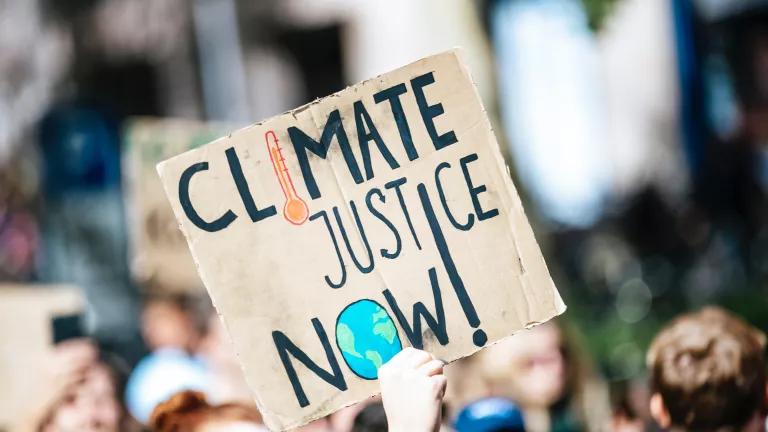2020 Laid Groundwork for Bold Climate Action in 2021

Part of NRDC's Series Reviewing 2020 Climate & Clean Energy Developments
The victory of President-elect Joe Biden heralds great things for U.S. climate action. In 2021, we’ll leave behind the dark era of the Trump administration and its dangerous, retrograde policies. This month the United States will welcome a president who understands the climate crisis for what it is: An urgent priority for humankind.
The past year was unparalleled in many ways. Who could have predicted that in 2020 we would see record-shattering climate disasters in the U.S., but simultaneously a global pandemic, followed by an economic recession and widespread protests calling for racial justice? But out of these tumultuous events key lessons have emerged for simultaneously addressing these crises in wholistic, sustainable and unifying manner.
Solving the Climate Crisis is Intertwined with Economic Recovery and Racial Justice
Perhaps the biggest lesson that 2020 taught us is how deeply intertwined solving the climate crisis is with addressing economic and racial injustice. The U.S. House leadership has laid out in detail an integrated policy framework in their Climate Crisis Action Plan, by recognizing that good-paying jobs, equity, and justice must be at the center of any serious climate action plan. And President-elect Biden has also strongly embraced the need to take an all-encompassing approach to solving climate, economic, and racial crises.
Experience at the state-level reinforces the importance of this approach. New York’s Climate Leadership and Community Protection Act, with the nation’s strongest greenhouse gas limits, required assembling a broad coalition and a platform that also prioritizes the most at-risk communities. Similarly, California’s groundbreaking Advanced Clean Truck rule was supported by a broad coalition of environmental, community-based and labor groups.
Clean Energy Progress Continues
The past year has presented the twin challenges of a hostile administration and a deep recession. Yet clean energy has proven to be remarkably resilient, and has continued to make progress while the dirtiest fossil fuel, coal, continued its inevitable decline. In fact, DOE just reported that in 2019 U.S. renewable energy consumption surpassed coal for first time in over 130 years. Clean energy would have made even more progress if it had not been for Trump’s relentless assault on clean energy standards and environmental protections.
Reversing these rollbacks and developing the next generation of standards for power plants, vehicles, buildings, and oil & gas production must be among the top priorities for the Biden administration if we are to meet the Biden climate plan goals of net zero emissions by at least 2050, carbon-pollution free power sector by 2035, and 100 percent zero-emission vehicle sales.
States and Cities Continue to Lead Way on Climate Policies
Despite Trump’s attempts to turn back the clock, market inevitabilities and strong state and city leadership have maintained clean energy momentum. Nowhere is this better illustrated than Trump’s attempted rollback of federal clean car regulations being countered by California and other states moving forward with a voluntary agreement with five automakers, a groundbreaking rule for zero-emission trucks, and a new target of 100 percent zero emission car sales by 2035. And in a sign the market understands the clean car states will win, the all-electric automaker Tesla is now the most valuable car company in the world, worth over $600 billion, more valuable than the next nine largest automakers combined.
New Federal Leadership, Hope for Greater Bipartisan Action
But perhaps the most important outcome of 2020 is that the presidential candidate with the strongest national climate plan ever won the most popular votes in our nation’s history, providing a strong mandate for climate action. And to implement this plan, he was assembled a climate “dream team” of experienced and committed appointees who can hit the ground running (including of course the current NRDC president, Gina McCarthy, as the nation’s first-ever National Climate Advisor).
And as another indicator that progress can be made at the federal level, the year ended with the passage of a bipartisan legislation that included a phase out a global-warming super-pollutant hydroflurocarbons, or HFCs, used in air conditioners, refrigerators, and other applications, which was the top climate win of the just-completed 116th Congress.
As NRDC experts point out in this series of blogs, putting Biden’s plan into action does not have to wait for congressional action. Biden can start by unraveling the Trump regulatory rollbacks, rejoining the Paris Climate Agreement, setting new carbon pollution standards, and directing public investments to address environmental justice and the health crisis.
The Path Forward
There is much work to be done to confront the climate crisis. Fortunately, out of the chaos and unpredictability of 2020, has emerged a new, unifying approach to tackle the climate, economic, and racial justice crises in an integrated manner. With a president who ran on the strongest national climate plan ever—coupled with continued leadership at the state and city levels—the U.S. has a critical opportunity to avert an even worse climate crisis.
There’s no time to waste.



